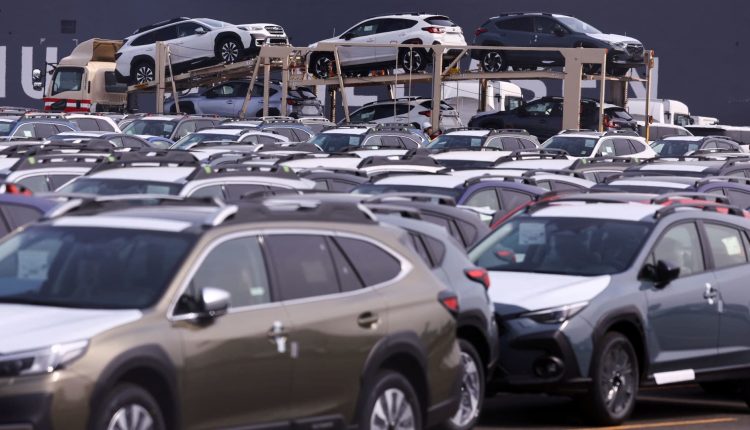Newly produced cars that are waiting to export in a port in Yokohama, south of Tokyo, Japan, on March 27, 2025.
Issei Kato | Reuters
The US President Donald Trump signed an execution order on Thursday for the implementation of a trade agreement with Japan with 15% from the basic tariffs for most Japanese goods, including cars.
The deal had been completed in July after months of negotiations, with Washington and Tokyo fluctuating about details for weeks before it was signed.
As part of the deal, Tokyo declared to invest 550 billion US dollars in projects selected by the US government, and increased the purchase of American agricultural products such as corn and soybeans as well as in US trade aircraft and defense equipment.
The US ally in Asia will also offer “breakthrough openings in market access” in the manufacture, in the aerospace, in agriculture and in the automotive sector, according to the order on Thursday. The agreement achieved in July included Japan, 100 Boeing aircraft, 75% higher imports for US rice and agricultural and harvest products worth 8 billion US dollars.
Washington will apply a tariff of 15% to almost all Japanese imports, with sector-specific taxes for automobiles and parts (also 15%), aviation products, generic drug goods and natural resources in accordance with the executive order.
The arrangement on Thursday prevents Trump’s country -specific tariffs in addition to the existing taxes. The lower tariffs apply retrospectively to Japanese goods, “for consumption or consumption from the warehouse on August 7, 2025 after the consumption of January 12, 2001.
Trump’s global tariff campaign has disrupted the global supply chain, especially Japan’s massive car sector. Last month, Toyota It warned that it had expected a goal of almost $ 10 billion because Trump’s tariffs for cars burdened its turnover to the USA and forced him to reduce its forecast for the total annual profit by 16%.
It is expected that the tariffs will also reach competitors, with Ford’s adjusted profit allegedly falling by $ 3 billion, while GM occurs $ 4 billion of US $ 5 billion for the year.
Japan’s top trade negotiator, Ryosei Akazawa, who was in Washington, provided a letter from Japanese Prime Minister Shigeru Ishiba, where he invited Trump to visit his country, Kyoto News reported. According to reports, the Japanese official had reported his trip to the United States last month, since some embroidery points required “further technical discussion”.
Political tides
The conclusion of the business came at home as a political pressure for the Japanese leader. The ruling Liberal Democratic Party at the beginning of this week published a long-awaited report on why she lost seats in the upper house elections in July.
The report was attributed to the loss of the deficiency in the Measure of the Party for Taming Inflation, former political scandals and the weak mobilization of young voters.
Local media reports suggested that many important members of the LDP signal their intention to withdraw the Prime Minister, while Ishiba declares that he intended to call in his party in his party to choose another guide.
Although the reports have been avoided to name individuals, they signal an “implicit charges against Ishiba’s leadership of the party,” said James Brady, Vice President of Teneo’s political advice.
The analysts of the Eurasien Group proposed in a report on Friday that Ishiba will not survive a challenge from the party next Monday if a vote as to whether a management election is to be made should probably take place.
“The poor performance of Ishiba as party leaders in the elections and events in the lower and upper house in the last few days, including the former Prime Minister Asso Taro, who announced his support for the special elections, turned the flood against Ishiba,” said analysts, which a 60% odd Ishibas defeat in the elections, since it may have returned before the votes will appear.


Comments are closed.